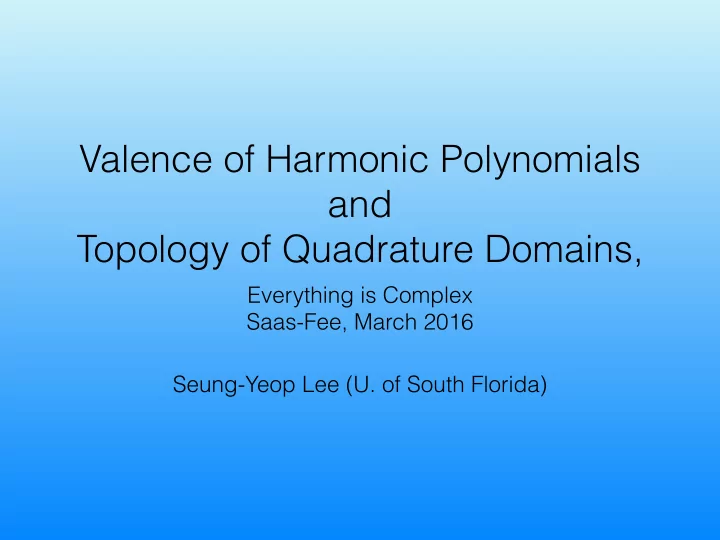

Valence of Harmonic Polynomials and Topology of Quadrature Domains, Everything is Complex Saas-Fee, March 2016 Seung-Yeop Lee (U. of South Florida)
Harmonic polynomials h ( z ) = p ( z ) + q ( z ) , z ∈ C . What is the maximal valence of h : C → C (deg p, deg q ) = ( n, m ) given ? Examples: h ( z ) = p 4 ( z ) + z : 10 zeros. h ( z ) = p 4 ( z ) + z 2 : 12 zeros?
Known Bounds (deg p, deg q ) maximal valence ≥ m 2 + m + n ( n, m ) n 2 ( n, n − 1) ≥ n 2 − (1 . 47052) n + O (1) ( n, n − 2) ≥ n 2 − 3 n + O (1) ( n, n − 3) ( n, 1) 3 n − 2 (Wilmshurst’s conjecture: m(m-1)+3n-2) (Khavinson, Swiatek, Geyer, Lundberg, Lerario, Lee, Saez, …)
The mapping h is orientation-reversing in L < = { z ∈ C : | p 0 ( z ) | < | q 0 ( z ) |} and it is orientation-preserving in . L > Defining N >,< : number of zeros in L > , L < Argument principle (for harmonic function h ) gives N > − N < = n. It is enough to count the orientation-reversing zeros .
Counting local minima The orientation-reversing zeros are the local minima of the following potential field. ✓Z z ◆ Q ( z ) = | q ( z ) | 2 + 2Re p ( w ) q 0 ( w ) dw . ⇣ ⌘ ( ) Q 0 ( z ) = q 0 ( z ) . p ( z ) + q ( z ) Local droplet (filling in Coulomb gas): support of s.t. µ Z dµ ( w ) 0 = Q 0 ( z ) − 1 z ∈ supp µ. z − w , π
(Generalized) Quadrature Domains Then is the (union of) “quadrature domains”. Ext(supp µ ) Z X f ( z ) | q 0 ( z ) | 2 dA ( z ) = c k f ( k ) ( a k ) . Ω Equivalently, given the Schwarz function of the domain, S q ( S ( z )) is a meromorphic function of the domain. Deltoid Cassini’s oval Harmonic polynomial with k orientation-reversing zeros gives an unbounded quadrature domain with k holes .
From QDs to Harmonic Polynomials Theorem 1 (L-Makarov) A (meromorphic) Schwarz function of the quadrature domain is quasi-conformally equivalent to a rational function. For , the existence of certain unbounded QD deg q = 1 with k holes implies the existence of the harmonic polynomials with orient.-rev. k zeros. Q: Find a QD with maximal number of “holes”.
Suffridge curves The conformal image of the exterior unit disk under the mapping: 1 f ( z ) = z + a 1 a d − 1 z + · · · + dz d . ( d − 1) z d − 1 −
Idea of the proof. S : The space of all univalent f . f ( z ) = z + a + ib 1 + a − ib 4 z 4 . − 2 z 2 z Theorem 2 (L-Makarov). Extreme points of S give Suffridge curves.
Proof of Theorem 1: From QDs to Harm. Polynomials. The Schwarz reflection is anti-analytic in the QD . ( This is our version of “polynomial-like mapping” in the Douady- Hubbard straightening theorem. ) We want to find a q.c. homeomorphism such that the Schwarz refl. is q.c.- conjugated to a (anti-analytic) polynomial mapping . q.c. S p
The region of q.c. distortion is ∞ − j (deltoid) [ S j =1 (the filled Julia set of the Schwarz reflection.) q.c.
q.c.
Rational case Theorem . There exists a rational function r such that r ( z ) + z = 0 � has the maximal number of roots that is given by min( d + n − 1 , 2 d − 2)
(Steffen Rhode, Brent Werness)
Recommend
More recommend